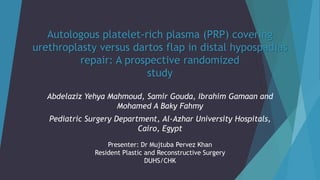Journal Club 'Autologous platelet-rich plasma (PRP) covering urethroplasty versus dartos flap in distal hypospadias repair: A prospective randomized study'
- 1. Autologous platelet-rich plasma (PRP) covering urethroplasty versus dartos flap in distal hypospadias repair: A prospective randomized study Abdelaziz Yehya Mahmoud, Samir Gouda, Ibrahim Gamaan and Mohamed A Baky Fahmy Pediatric Surgery Department, Al-Azhar University Hospitals, Cairo, Egypt Presenter: Dr Mujtuba Pervez Khan Resident Plastic and Reconstructive Surgery DUHS/CHK
- 2. Literature ? Soft tissue coverage over the urethra, important factor affecting the outcome ? Protective layer between the neo-urethra and the skin reduces fistulas and overall complications ? Despite the use of covering flaps in hypospadias surgery, it is still a matter of debate by some authors. ? PRP is an autologous concentrate of platelets in a small volume of plasma containing biologically active factors responsible for hemostasis, synthesis of new connective tissue and revascularization
- 3. PRP for hair loss PRP for Arthritis
- 5. PRP for Alveolar Cleft
- 6. Discussion ? >250 techniques have been reported ? Fistula rate varies from 3 to 10% ? Different techniques for second layer coverage ? No accordance among pediatric urologists on the most effective technique
- 8. Tunica vaginalis Buccal / Lower lip mucosa graft
- 9. Dartos layer Fibrin glue layer Spongioplasty
- 10. Aim ? To evaluate and to compare the use of PRP covering layer and dartos flap layer in regard to complication rates in Snodgrass (TIP) hypospadias repair.
- 11. Methods ? RCT ? October 2011 to December 2016 ? Total 180 patients ? Mean age 27.9 months ? Randomization was achieved through sealed envelopes
- 12. ? Group A (n= 90) ? PRP layer group ? Lost to follow up = 3 ? Group B (n= 90) ? Dartos flap group ? Lost to follow up = 5
- 13. Inclusion Criteria ? Primary cases ? Sub coronal, distal and mid penile with minimal chordee Exclusion Criteria ?Proximal hypospadias ?UCF ?Moderate to severe chordee ?Previous topical androgen therapy
- 14. Parameters ? Operative time ? Early and late post op complications ? Urinary stream ? Aesthetic appearance
- 15. Operative Procedure ? 10cc blood drawn ? PRP extracted by double centrifuge ? Calcium chlorate was added ? Incubated at 37ĪŃC for 3 mins until red clot was obtained
- 17. Operative Procedure ? PRP sheet was applied (vicryl 7/0) after tubularization (vicryl 6/0) ? Skin was closed ? 8 -12 F catheter was used ? Dressing removed on 4th P.O.D ? Catheter kept for 7-10 days ? Urinary stream was observed in all patients
- 18. Statistical Analysis ? 95% confidence interval ? 80% power of the study ? 5% error ? Chi squared test was applied ? P <0.050 was considered significant
- 19. Results
- 20. Results ? A, PRP group = 124.6 minutes ? B, Dartos group = 136.4 minutes ? P >0.10, statistically insignificant Operative time
- 22. Results ? A slit-like neo-meatus on the tip of the glans was obtained in most of the cases. ? Parents were asked to evaluate the cosmetic appearance of the penis as good, acceptable, bad or indifferent. The cosmetic result was reported as good in 73% of group A and 69% of group B. Cosmetic appearance
- 23. Critique ? Introduction ? Methods ? Statistics ? Results ? Conclusion
- 24. Strengths ? No additional cost involved as in fibrin glue ? May be reproducible in out setup
- 25. Limitations ? Single center study ? Small randomized study ? Needs comparison with other techniques
- 26. In our setupĪŁ
- 28. Thankyou.




























